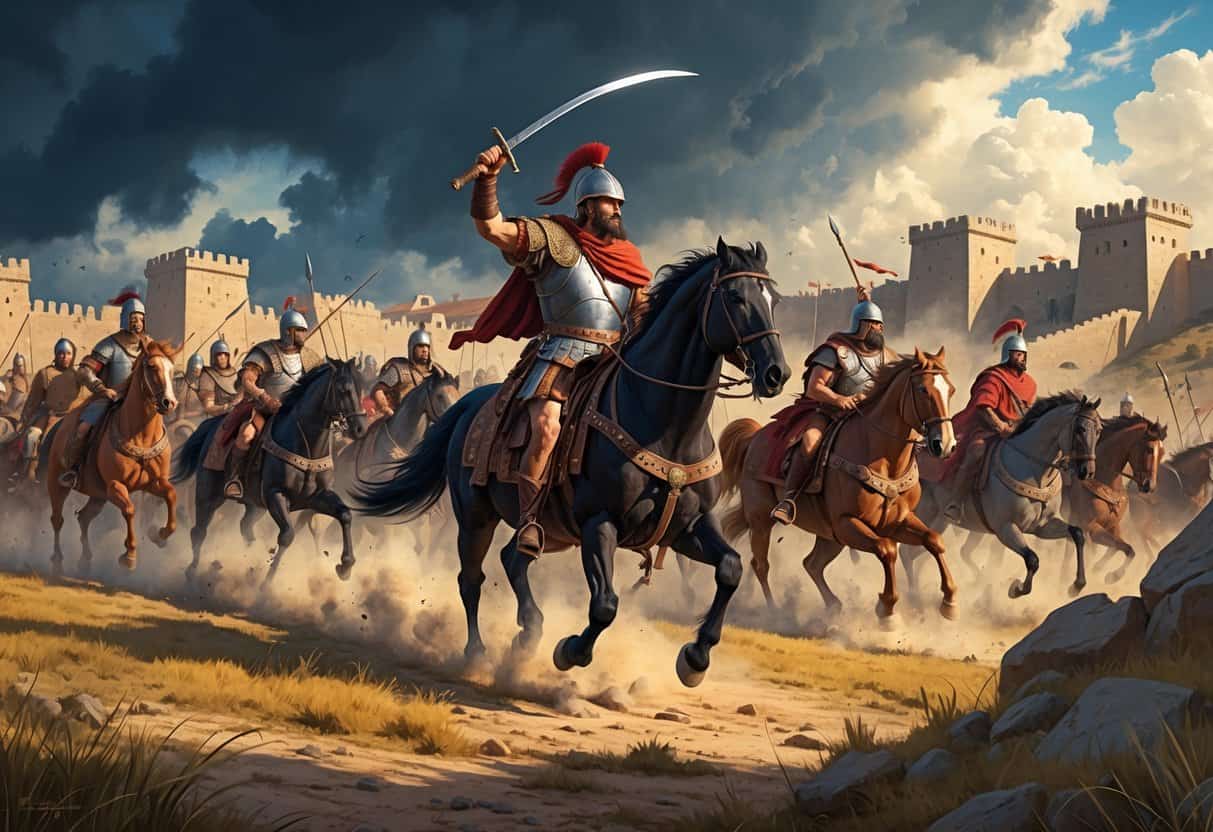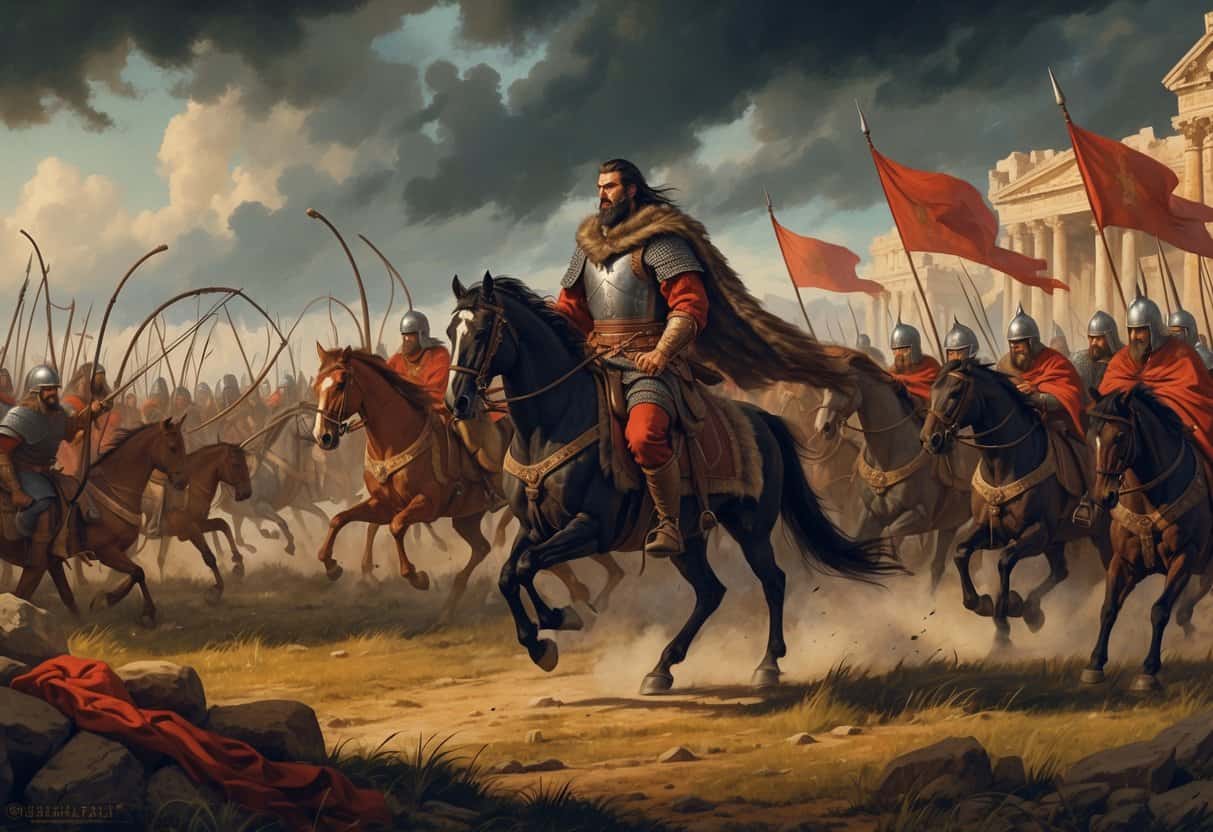Attila the Hun led a series of invasions into the Roman Empire during the 5th century. His attacks stretched across Roman territories in Gaul and Italy, putting enormous pressure on the empire.

The Huns, under Attila’s command, used bold military strategies to cross natural barriers like the Rhine River and attack Roman lands. Rome suddenly faced new threats from these fierce warriors, who were unlike the usual tribes the empire had dealt with.
If you want to learn how these invasions shaped the fall of Rome, this guide highlights the most crucial events and facts.
Key Takeaways
- Attila’s invasions put strong pressure on the Roman Empire’s borders.
- The Huns used new military tactics that challenged Roman defenses.
- These invasions contributed to major changes in the Roman world.
Background: The Huns and the Roman World

To really get why the Huns were such a big deal, you’ve got to know where they came from and what the Roman Empire looked like around Attila’s time. The political and military mess before his invasions made things even more unpredictable.
Origins and Culture of the Huns
The Huns were skilled horsemen from Central Asia. They lived on the Ponto-Caspian Steppe, a massive grassland north of the Black Sea.
Their life was nomadic, and they relied on horses for almost everything—travel, fighting, even daily chores. These folks didn’t build cities or have a government like Rome did, but they were organized under strong chieftains.
Their culture revolved around conquest and plunder. That reputation made them genuinely feared by their neighbors.
The Roman Empire at the Time of Attila
During Attila’s rule in the 5th century, the Roman Empire was split in two: the Western Roman Empire and the Eastern Roman Empire.
The Western half was weak, struggling with all sorts of internal problems and constant pressure from Germanic tribes like the Goths and Ostrogoths. The Eastern Roman Empire, or Byzantine Empire, was stronger but not exactly safe from threats either.
The Roman military just wasn’t what it used to be. Recruitment was tough, and they had to rely more and more on barbarian troops.
Both halves of the empire faced the challenge of defending their borders from invasions.
Political and Military Context Before the Invasions
Right before Attila’s invasions, things were fragile. The empire’s borders were constantly threatened by groups like the Germanic peoples and Slavs.
The Huns had already pushed tribes like the Goths into Roman territory, which stirred up tension and conflict as these groups tried to settle in.
Rome tried to handle the Huns with treaties and by paying tribute. But as Attila’s power grew, that strategy just didn’t cut it anymore.
The Roman military was stretched thin, and political infighting made it even harder to respond. All of this set the stage for the massive invasions that followed.
Attila the Hun’s Invasions: Major Campaigns and Battles
Attila led his armies across key Roman territories, always aiming for tribute and control. His campaigns ranged from the Danube frontier through Gaul and deep into Italy.
His style mixed lightning-fast strikes with clever negotiations.
Invasion of the Eastern Roman Empire
Attila first set his sights on the Eastern Roman Empire, crossing the Danube and attacking cities in Dacia and Thrace. His forces besieged Philippopolis and Arcadiopolis, cutting off Roman trade and communication.
He threatened Constantinople and controlled access to the Propontis, which forced the Eastern Romans to pay heavy tribute.
Even though Constantinople never actually fell, Attila’s military pressure was enough to spark fear and force the Romans to negotiate. That meant he got what he wanted without having to sit through endless sieges.
The Western Campaigns: Gaul and Italy
Then came the push into Gaul, where Attila targeted Roman control in what’s now France. His invasion destroyed towns, and the fighting near Orleans was especially intense.
The Battle of Chalons was a turning point. Attila’s forces clashed with a coalition of Roman soldiers and allies. The battle was brutal and, honestly, it stopped the Huns from pushing further into Gaul.
Later, Attila invaded Italy. He sacked cities, disrupted trade, and even threatened Rome itself. Pope Leo I met with him personally, and somehow, that meeting convinced Attila to turn back before attacking the city.
Strategies and Tactics of Attila’s Armies
Attila’s armies relied on fast-moving cavalry for quick strikes. They’d hit targets and then vanish before Roman soldiers could catch up.
He often targeted roads and communication lines, isolating cities and making it hard for Rome to respond. Intimidation and surprise were his trademarks.
Attila balanced brutal force with tough negotiations. He’d push for tribute when his enemies were stretched thin or when a siege would drag on too long.
That mix of warfare and diplomacy made him a ruler nobody wanted to cross.
Impact and Legacy of Attila’s Invasions
Attila’s invasions left a deep mark on the Roman Empire’s power and culture. His attacks weakened the Western Roman Empire and changed life for countless people.
Consequences for the Roman Empire
Attila’s invasions put a huge strain on the Western Roman Empire’s resources. Cities were pillaged, farmland was ruined, and trade routes broke down.
The Eastern Roman Empire, or Byzantine Empire, survived but paid dearly in gold and stability. People in the affected regions faced food shortages and lived in constant fear.
Attila never fully invaded the East, but his threats made the empire’s vulnerability painfully obvious.
Cultural and Social Changes
Life for ordinary Romans changed fast. Homes and cities were damaged, and daily routines like work, entertainment, and worship were thrown off.
Clothing styles and goods became harder to make or trade. Christianity gained even more followers as people looked for hope during all the chaos.
Over time, the mix of Roman traditions and barbarian influences started to shape new cultures, setting the stage for what would become the Dark Ages.
Attila’s Role in Ancient and Modern History
Attila’s usually pictured as a fierce leader, both in dusty textbooks and the stories people pass along. His name gets tangled up with the fall of Rome, though let’s be honest, there were plenty of other things going on too.
You’ll spot him in guides by CH Publications or in the work of historians like Ian Hughes. Folks keep digging into his life, trying to figure out what made him tick.
Today, Attila pops up as this symbol of invasion and raw power. His story threads through ancient history, from Rome’s earliest days to the wild eras of Nero and Constantine.
Trying to wrap your head around his legacy? It just might help you see how empires rise, stumble, and how the past keeps nudging the present.